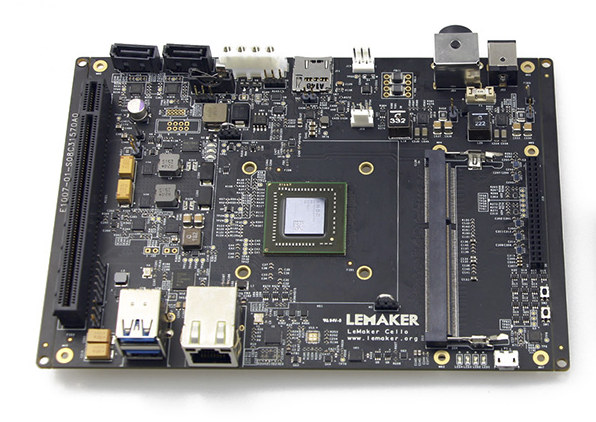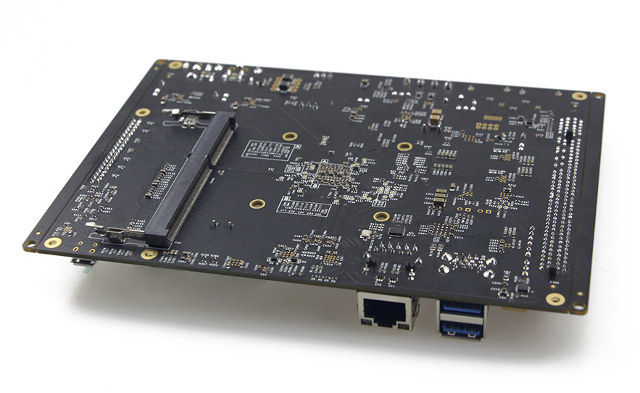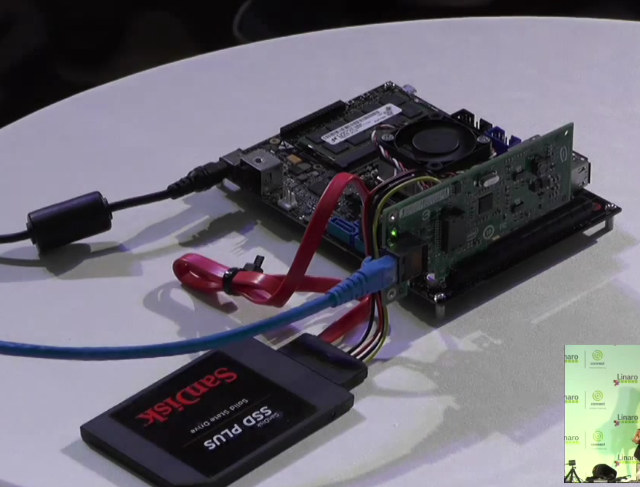There are two versions of Linaro’s 96Boards specifications the Consumer Edition (CE) and the Enterprise Edition (EE) with higher hardware requirements, and while several boards mostly compliant with 96Boards CE are available such as DragonBoard 410c and Hikey boards, the only board announced to be compliant with 96Boards EE specifications was AMD Huskyboard based on Opteron A1100 series processor and is yet to be available for sale. LeMaker has now designed a similar EE boards called Cello.
 LeMaker Cello board specifications:
LeMaker Cello board specifications:
- Processor – AMD Opteron A1120 quad core Cortex A57 processor @ 1.7 GHz with 2MB L2 cache, 8MB L3 cache
- System Memory – 2x DDR3 SO-DIMM sockets
- Storage – 2x SATA 3.0 ports, micro SD slot
- Connectivity – 1x Gigabit Ethernet RJ45 port
- USB – 2x USB 3.0 ports
- Expansions
- x16 PCIe G3 slot
- 40-pin Low Speed (LE) expansion header
- Debugging – micro USB port for console access, 10-pin JTAG connector
- Power Supply – 4-pin power connector
- Dimensions – 160×120 mm as per 96Boards EE specifications
- Weight – 500 grams (Package weight)
The board don’t show an heatsink, but the holes are there, and considering the SoC has a whopping 25W TDP, an heatsink and likely fan will likely be required. There’s also no information about operating systems, but the latest Linaro Reference Platform release for Enterprise supports Debian 8.3 and an image based on Centos 7.2, as well as UEFI with ACPI, KVM and PCIe support.
 The board can be pre-ordered for $299 on LeMaker Cello product page with shipping schedules for Q2 2016.
The board can be pre-ordered for $299 on LeMaker Cello product page with shipping schedules for Q2 2016.
Via Mininodes
[Update: So I’ve been watching Linaro BKK 2016 keynote, and there was a demo with Huskyboard (similar to Cello featured in that post) running the developer preview of Red Hat Enterprise Linux Server release 7.2 (MaiPo). That’s what the board is supposed to look like with a heatsink and fan. They’ve also added a PCIe network card to show that PCIe is also working

]

Jean-Luc started CNX Software in 2010 as a part-time endeavor, before quitting his job as a software engineering manager, and starting to write daily news, and reviews full time later in 2011.
Support CNX Software! Donate via cryptocurrencies, become a Patron on Patreon, or purchase goods on Amazon or Aliexpress. We also use affiliate links in articles to earn commissions if you make a purchase after clicking on those links.





AMD’s Seattle SoCs feature 2 10GbE Ethernet ports, 14 SATA 3.0 ports and 8 PCIe 3.0 lanes (so x16 is x8 in reality). And what do we get here? 1 x GbE and 2 x SATA on an insanely overprized board (if they would’ve used the octa-core A1170 instead that AMD sells for $150 the board’s price would be somewhat ok).
Who should buy this board? Obviously only devs trying to learn how ARM Trusted Firmware and UEFI work. If you’re done with that you can throw the board away. Why didn’t they expose at least 8 more SATA ports and 10GbE? That would’ve made a nice alternative to Intel Avoton NAS boards…
@tkaiser
one more thing, this is supposed to be server grade hardware but they never mention ECC RAM support…
I know this AMD SoC supports it though.
@nobe
True, the SoC would also support DDR4 (ECC) and then you could use up to 128 GB RAM if/when modules become available/affordable. But maybe manufacturing something that’s only useful for dev and not production purposes is also part of the 96boards standard?
@tkaiser
If ECC is supported, then this is the lowest-cost cortex-A57 board available. I would be more than glad to be corrected on this. 🙂
$300 is not nice price, but still competitors are twice more expensive (NVidia) or even more (AMCC/Cavium). Also if you need 10 GigE or more SATAs, then you can go with another Seattle Opteron boards, but they are not in this price range…
Well, and if you like Avoton, go and purchase Avoton board, nobody enforces you to purchase this dev board anyway…
LeMaker are slowly but steadily rising in my list of ‘riding the price premium on high-demand low-availability products’ vendors.
@kcg
I’d like to have an alternative to Avoton boards (productive use) and I want to be able to start testing ‘server stuff on ARM that matters’ (developer use) which is unfortunately rather limited with this board. It would’ve been great if we could start to check out the state of 10GbE or btrfs RAID 5/6 on ARM if there would be a few more SATA ports exposed (12 of them not being used — it’s a shame).
Please remember: We had serious issues with XFS on ARM in the past (data corruption!) therefore testing code on the architecture in question is important.
Well this is interesting and all but 25W TDP for just 4 A57 cores @ 1.7 Ghz ? Emm … doesn’t sound too nice. I’d expect 8 cores at that TDP and an much higher frequency.
Maybe the next AMD ARM SOC will be more interesting… this one seems too little , too late.
@Marius
Please consider x8 PCIe 3.0, 2 x 10GbE and 14 x SATA when thinking about the 25W. And this is the stuff that would need intensive testing: Are there internal bandwidth limitations that prevent maximum throughput (compare with i.MX6 for example where GbE doesn’t exceed 400 Mbits/sec)? How many SATA lines can be saturated at a time? Will 10GbE performance drop when SATA is used concurrently? Same for PCIe… and so on…
Since this board doesn’t expose the most interesting stuff maybe you can save the heatsink already. Regarding TDP: the octa core A1170 is listed with 32W@2GHz so you know how network and I/O engines add up to the TDP budget already.
the more I hear about that 96board standard, the more I get sick of it. Is their mission to discourage people? Will wait for something better at the server arm horizon.
@blu
Yes, from Bananpi to 96boards, it is a big step.
If you are serious about XFS testing on ARM etc. then perhaps you shall get some SoftIron boxes holding non-crapped A1100 version or some gigabyte box with either amcc or cavium armv8 soc inside.
Another way may be to just put LSI card into PCIe and hook planty of discs there. For testing XFS just one GigE should not hurt you, shouldn’t it?
AMD never ceases to show mediocrity in their products, a57 instead of a72, and that power consumption, might as well buy a laptop with Core M for that price.
@kcg
I don’t want to test XFS, that was just an example that testing the architecture you’re interested in matters. The things I want to test are how A11xx behaves in ‘real world’ scenarios and that’s simply impossible with this LeMaker product where everything that matters isn’t routed to the outside.
The board is now listed on 96Boards EE page together with Huskyboard @ http://www.96boards.org/products/ee/
Qualcomm Q2432LZB enterprise (server?) board is being worked on at Linaro, and is supported their software reference platform according to https://github.com/Linaro/documentation/blob/master/Reference-Platform/Highlights.md
I have no details about the hardware at all.
@cnxsoft
So the processor is Qualcomm QDF2432 -> https://github.com/Linaro/documentation/blob/118fe5b3db82e5eb4b8ee192aa7ca9040b71f751/Reference-Platform/RPTest/EnterpriseEdition/Q2432LZB/README.md
Some reference in mainline kernel: https://lkml.org/lkml/2016/2/5/378
@cnxsoft
Qualcomm server chips will be called Centriq. They wrote a press release about the name, but without providing much other details, except MP is scheduled for the end of the year -> https://www.qualcomm.com/news/onq/2016/08/18/meet-qualcomm-centriq-latest-member-qualcomm-technologies-expanding-family
Well, already 3 years passed and in that time Huskyboard goes missing or cancelled while LeMaker Cello was only made in very limited quantities (not even 3 digits) and still wrangling with a broken PCI Express bus. Clues https://production.platforms.linaro.org/documentation/Reference-Platform/Releases/RPB_16.06/EnterpriseEdition/Cello/ and https://www.96boards.org/blog/lemaker-cello-bringup/ Any news about AMD’s ARM Opterons also dried up quickly not long after final “launch”.